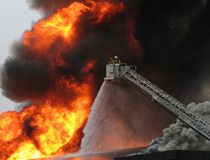| Editor’s note: A fire chief’s daring maneuver to drive an aerial truck while firefighters were still aloft in the bucket has prompted much debate among experts. Here, FireRescue1 columnists and Billy Goldfeder, from FirefighterCloseCalls.com, discuss what happened and what can be learned. |
Fred LaFemina, a 21-year veteran of the FDNY and FireRescue1’s Fire Operations columnist.
“The article states they were venting the roof — there should be no roof venting on these types of structures, meaning they should not have been up there.
“They were not anticipating collapse, which they should have. The apparatus was not in a good position in the event of a collapse. Even if they were not in the initial collapse zone, I believe they failed to recognize the severity of the fire. The bottom line is that there were two less funerals to attend. However, training and education may have removed them from this scenario.”
Billy Goldfeder, deputy chief of the Loveland-Symmes Fire Department in Ohio, who also helps run FirefighterCloseCalls.com.
“This looks like an unnecessary and dangerous act. Why not just bed the boom and get out of the basket? They were only a few feet up.They were still able to reposition a pumper after the tower was moved so the radiant heat was probably still tolerable.
“And then the bigger issue is actually the bow strung truss roof. The experts (Dunn, Brannigan, etc.) have taught us that under no circumstances during a fire should a firefighter operate on or under that kind of roof.
“From Hackensack Ford to Waldbaums in Brooklyn and the many others, these roofs are firefighter death traps. Need to vent? Do it safely from an aerial or tower, or just let it vent itself. If the building owners care that much, the building would be sprinklered.”
Bob Vaccaro, former chief of the Deer Park Fire Department on Long Island and FireRescue1’s Apparatus Essentials columnist.
“The chief did what he had to do to save his firefighters. Is this the right way to do it? Only those at the scene know what really went on. All manufacturers will tell you not to make a move like this with any aerial platform, as in most cases it will probably cause it to tip over. Why it didn’t was probably luck.
“If the fire was gaining headway and conditions were starting to deteriorate, why the firefighters didn’t climb down off the aerial, or move the aerial away from the fire sooner is a question. But as I wasn’t there, it’s hard to make a determination. At the spur of the moment the chief did what he thought was best to save his men.”
|
|
Chris Daly, Drive to Survive Training Program creator and FireRescue1 columnist.
“While the incident will provide countless hours of tailboard and coffee-table debates, we all must ask ourselves, ‘What would we have done?’”
“Certainly a maneuver such as this is risky and unsafe. Moving a vehicle with the aerial in the air could cause the vehicle to tip over due to the elevated center of gravity. In this case, two firefighters were faced with what appeared to be an immediate life and death situation. While no manufacturer or driver training instructor would advocate moving an apparatus with the aerial in the air, in this case it was done. As a result, whether it was luck or good fortune, the vehicle did not tip over and both firefighters were safely removed from the bucket.
“This incident provides several great lessons that we can all learn from. The video clearly shows how quickly fire conditions can change. When placing apparatus for defensive operations, we must think minutes or even hours into the game. Remember to leave plenty of room between your apparatus and the fire building.
“Be aware of collapse zones, overhead obstructions and the possibility that changing fire conditions may impinge upon your vehicle. Maintain a good eye on smoke conditions and be aware of what the smoke is telling you. Does flashover appear imminent? If so, perhaps it is time to reposition the apparatus and seek a safer place to conduct operations. If you are unable to safely move the apparatus, can you move the bucket or aerial away from the fire and protect the vehicle with master streams? Are the members able to climb to safety and remove themselves from the impinging smoke and fire?
“The video of this incident clearly shows the speed at which the fire changed from heavy smoke to heavy fire. Remember that it will take you a lot longer to safely reposition your apparatus than it will take for the fire to flashover. By using this incident as a learning experience, we can all pursue safer ways to perform defensive operations.”
|


